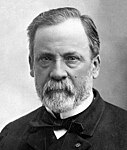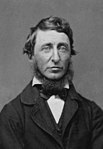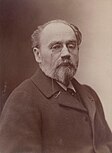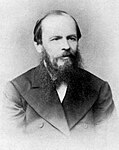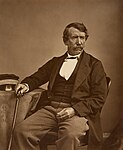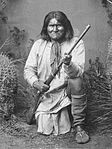19 -й век

| Тысячелетие |
|---|
| 2 -е тысячелетие |
| Столетия |
| Сроки |
| State leaders |
| Decades |
| Categories: |
|
Births – Deaths Establishments – Disestablishments |
начался 19 -й век 1 января 1801 года (представлена римскими цифрами MDCCCI) и закончился 31 декабря 1900 года (MCM). Это характеризовалось огромными социальными потрясениями. Рабство было отменено в большей части Европы и Америки . Первая промышленная революция , хотя и началась в конце 18 -го века , впервые расширилась за пределы своей британской родины в течение 19 -го века, в частности, переделав экономику и общества низких стран , Рейнленд , северная Италия и северо -восточные Соединенные Штаты Полем Через несколько десятилетий вторая промышленная революция привела к еще более масштабной урбанизации и гораздо более высоким уровням производительности, прибыли и процветания, схемы, которая продолжалась в 20 -м веке .
In the Middle East, it was an era of change and reform. The Islamic gunpowder empires fell into decline and European imperialism brought much of South Asia, Southeast Asia, and almost all of Africa under colonial rule. Reformers were opposed at every turn by conservatives who strove to maintain the centuries-old Islamic laws and social order.[1] В 19-м веке также увидел крах крупных испанских и могольных империй, которые проложили путь к растущему влиянию британских , французских , немецких , российских , австро -венгерских , итальянских и японских империй вместе с Соединенными Штатами .
Following the defeat of France in the Napoleonic Wars, the British and Russian empires expanded considerably, becoming two of the world's leading powers. Russia expanded its territory to the Caucasus and Central Asia. The Ottoman Empire underwent a period of Westernization and reform known as the Tanzimat, vastly increasing its control over core territories in the Middle East. However, it remained in decline and became known as the sick man of Europe, losing territory in the Balkans and North Africa.
The remaining powers in the Indian subcontinent, such as the Maratha and Sikh empires, suffered a massive decline, and their dissatisfaction with the British East India Company's rule led to the Indian Rebellion of 1857 and the company's dissolution. India was later ruled directly by the British Crown through the establishment of the British Raj. During the post-Napoleonic era (after 1815), Britain enforced what became known as the Pax Britannica, which ushered in unprecedented globalization on a massive scale. Britain's overseas possessions grew rapidly in the first half of the century, especially with the expansion of vast territories in Canada, Australia, India, and in the last two decades of the century in Africa. By the end of the 19th century, the British controlled a fifth of the world's land and a quarter of the world's population.
By the end of the century, Britain, France, Germany, and the United States had colonized almost all of Oceania. In East Asia, China under the Qing dynasty endured its century of humiliation by foreign powers that lasted until the first half of the 20th century. The last surviving man and woman, respectively, verified to have been born in the 19th century were Jiroemon Kimura (1897–2013) and Nabi Tajima (1900–2018), both Japanese.
Overview
[edit]
The first electronics appeared in the 19th century, with the introduction of the electric relay in 1835, the telegraph and its Morse code protocol in 1837, the first telephone call in 1876,[2] and the first functional light bulb in 1878.[3]
The 19th century was an era of rapidly accelerating scientific discovery and invention, with significant developments in the fields of mathematics, physics, chemistry, biology, electricity, and metallurgy that laid the groundwork for the technological advances of the 20th century.[4] The Industrial Revolution began in Great Britain and spread to continental Europe, North America, and Japan.[5] The Victorian era was notorious for the employment of young children in factories and mines, as well as strict social norms regarding modesty and gender roles.[6] Japan embarked on a program of rapid modernization following the Meiji Restoration, before defeating China, under the Qing dynasty, in the First Sino-Japanese War. Advances in medicine and the understanding of human anatomy and disease prevention took place in the 19th century, and were partly responsible for rapidly accelerating population growth in the Western world. Europe's population doubled during the 19th century, from approximately 200 million to more than 400 million.[7] The introduction of railroads provided the first major advancement in land transportation for centuries, changing the way people lived and obtained goods, and fuelling major urbanization movements in countries across the globe. Numerous cities worldwide surpassed populations of a million or more during this century. London became the world's largest city and capital of the British Empire. Its population increased from 1 million in 1800 to 6.7 million a century later. The last remaining undiscovered landmasses of Earth, including vast expanses of interior Africa and Asia, were explored during this century, and with the exception of the extreme zones of the Arctic and Antarctic, accurate and detailed maps of the globe were available by the 1890s. Liberalism became the pre-eminent reform movement in Europe.[8]

Slavery was greatly reduced around the world. Following a successful slave revolt in Haiti, Britain and France stepped up the battle against the Barbary pirates and succeeded in stopping their enslavement of Europeans. The UK's Slavery Abolition Act charged the British Royal Navy with ending the global slave trade.[9] The first colonial empire in the century to abolish slavery was the British, who did so in 1834. America's Thirteenth Amendment following their Civil War abolished slavery there in 1865, and in Brazil slavery was abolished in 1888 (see abolitionism). Similarly, serfdom was abolished in Russia in 1861.
The 19th century was remarkable in the widespread formation of new settlement foundations which were particularly prevalent across North America and Australia, with a significant proportion of the two continents' largest cities being founded at some point in the century. Chicago in the United States and Melbourne in Australia were non-existent in the earliest decades but grew to become the 2nd largest cities in the United States and British Empire respectively by the end of the century. In the 19th century, approximately 70 million people left Europe, with most migrating to the United States.[10]
The 19th century also saw the rapid creation, development, and codification of many sports, particularly in Britain and the United States. Association football, rugby union, baseball, and many other sports were developed during the 19th century, while the British Empire facilitated the rapid spread of sports such as cricket to many different parts of the world. Also, women's fashion was a very sensitive topic during this time, as women showing their ankles was viewed to be scandalous.

It also marks the fall of the Ottoman rule of the Balkans which led to the creation of Serbia, Bulgaria, Montenegro, and Romania as a result of the second Russo-Turkish War, which in itself followed the great Crimean War.
Eras
[edit]
- Industrial Revolution
- European imperialism
- British Regency, Victorian era (UK, British Empire)
- Bourbon Restoration, July Monarchy, French Second Republic, Second French Empire, French Third Republic (France)
- Belle Époque (Europe)
- Edo period, Meiji period (Japan)
- Qing dynasty (China)
- Nguyen dynasty (Vietnam)
- Joseon dynasty (Korea)
- Zulu Kingdom (South Africa)
- Tanzimat, First Constitutional Era (Ottoman Empire)
- Russian Empire
- Manifest destiny, Antebellum era, Reconstruction era, American frontier, Gilded Age (United States)
Wars
[edit]Napoleonic Wars
[edit]
The Napoleonic Wars were a series of major conflicts from 1803 to 1815 pitting the French Empire and its allies, led by Napoleon I, against a fluctuating array of European powers formed into various coalitions, financed and usually led by the United Kingdom. The wars stemmed from the unresolved disputes associated with the French Revolution and its resultant conflict.
In the aftermath of the French Revolution, Napoleon Bonaparte gained power in France in 1799. In 1804, he crowned himself Emperor of the French.
In 1805, the French victory over an Austrian-Russian army at the Battle of Austerlitz ended the War of the Third Coalition. As a result of the Treaty of Pressburg, the Holy Roman Empire was dissolved.
Later efforts were less successful. In the Peninsular War, France unsuccessfully attempted to establish Joseph Bonaparte as King of Spain. In 1812, the French invasion of Russia had massive French casualties, and was a turning point in the Napoleonic Wars.

In 1814, after defeat in the War of the Sixth Coalition, Napoleon abdicated and was exiled to Elba. Later that year, he escaped exile and began the Hundred Days before finally being defeated at the Battle of Waterloo and exiled to Saint Helena, an island in the South Atlantic Ocean.
After Napoleon's defeat, the Congress of Vienna was held to determine new national borders. The Concert of Europe attempted to preserve this settlement was established to preserve these borders, with limited impact.
Latin American independence
[edit]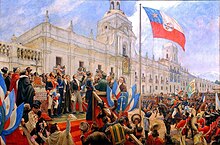
Mexico and the majority of the countries in Central America and South America obtained independence from colonial overlords during the 19th century. In 1804, Haiti gained independence from France. In Mexico, the Mexican War of Independence was a decade-long conflict that ended in Mexican independence in 1821.
Due to the Napoleonic Wars, the royal family of Portugal relocated to Brazil from 1808 to 1821, leading to Brazil having a separate monarchy from Portugal.
The Federal Republic of Central America gained independence from Spain in 1821 and from Mexico in 1823. After several rebellions, by 1841 the federation had dissolved into the independent countries of Guatemala, El Salvador, Honduras, Nicaragua, and Costa Rica.[11]
In 1830, the post-colonial nation of Gran Colombia dissolved and the nations of Colombia (including modern-day Panama), Ecuador, and Venezuela took its place.
Revolutions of 1848
[edit]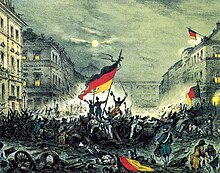
The Revolutions of 1848 were a series of political upheavals throughout Europe in 1848. The revolutions were essentially democratic and liberal in nature, with the aim of removing the old monarchical structures and creating independent nation states.
The first revolution began in January in Sicily.[clarification needed] Revolutions then spread across Europe after a separate revolution began in France in February. Over 50 countries were affected, but with no coordination or cooperation among their respective revolutionaries.
According to Evans and von Strandmann (2000), some of the major contributing factors were widespread dissatisfaction with political leadership, demands for more participation in government and democracy, demands for freedom of the press, other demands made by the working class, the upsurge of nationalism, and the regrouping of established government forces.[12]
Abolition and the American Civil War
[edit]
The abolitionism movement achieved success in the 19th century. The Atlantic slave trade was abolished in the United States in 1808, and by the end of the century, almost every government had banned slavery. The Slavery Abolition Act of 1833 banned slavery throughout the British Empire, and the Lei Áurea abolished slavery in Brazil in 1888.
Abolitionism in the United States continued until the end of the American Civil War. Frederick Douglass and Harriet Tubman were two of many American abolitionists who helped win the fight against slavery. Douglass was an articulate orator and incisive antislavery writer, while Tubman worked with a network of antislavery activists and safe houses known as the Underground Railroad.
The American Civil War took place from 1861 to 1865. Eleven southern states seceded from the United States, largely over concerns related to slavery. In 1863, President Abraham Lincoln issued the Emancipation Proclamation. Lincoln issued a preliminary[13] on September 22, 1862, warning that in all states still in rebellion (Confederacy) on January 1, 1863, he would declare their slaves "then, thenceforward, and forever free."[14] He did so.[15] The Thirteenth Amendment to the Constitution,[16] ratified in 1865, officially abolished slavery in the entire country.
Five days after Robert E. Lee surrendered at Appomattox Courthouse, Virginia, Lincoln was assassinated by actor and Confederate sympathizer John Wilkes Booth.
Decline of the Ottoman Empire
[edit]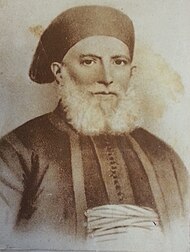
In 1830, Greece became the first country to break away from the Ottoman Empire after the Greek War of Independence. In 1831, the Bosnian Uprising against Ottoman rule occurred. In 1817, the Principality of Serbia became suzerain from the Ottoman Empire, and in 1867, it passed a constitution that defined its independence from the Ottoman Empire. In 1831, The First Egyptian–Ottoman War (1831–1833) occurred, between the Ottoman Empire and Egypt brought about by Muhammad Ali Pasha's demand to the Sublime Porte for control of Greater Syria, as reward for aiding the Sultan during the Greek War of Independence. As a result, Egyptian forces temporarily gained control of Syria, advancing as far north as Kütahya.[18] In 1876, Bulgarians instigated the April Uprising against Ottoman rule. Following the Russo-Turkish War, the Treaty of Berlin recognized the formal independence of the Serbia, Montenegro, and Romania. Bulgaria became autonomous.
China: Taiping Rebellion
[edit]
The Taiping Rebellion was the bloodiest conflict of the 19th century, leading to the deaths of around 20–30 million people. Its leader, Hong Xiuquan, declared himself the younger brother of Jesus Christ and developed a new Chinese religion known as the God Worshipping Society. After proclaiming the establishment of the Taiping Heavenly Kingdom in 1851, the Taiping army conquered a large part of China, capturing Nanjing in 1853. In 1864, after the death of Hong Xiuquan, Qing forces recaptured Nanjing and ended the rebellion.[19]
Japan: Meiji Restoration
[edit]During the Edo period, Japan largely pursued an isolationist foreign policy. In 1853, United States Navy Commodore Matthew C. Perry threatened the Japanese capital Edo with gunships, demanding that they agree to open trade. This led to the opening of trade relations between Japan and foreign countries, with the policy of Sakoku formally ended in 1854.
By 1872, the Japanese government under Emperor Meiji had eliminated the daimyō system and established a strong central government. Further reforms included the abolition of the samurai class, rapid industrialization and modernization of government, closely following European models.[20]
Colonialism
[edit]

- 1803: United States more than doubles in size when it buys out France's territorial claims in North America via the Louisiana Purchase. This begins the U.S.'s westward expansion to the Pacific, referred to as its Manifest Destiny, which involves annexing and conquering land from Mexico, Britain, and Native Americans.
- 1817 – 1819: British Empire annexed the Maratha Confederacy after the Third Anglo-Maratha War.
- 1823 – 1887: British Empire annexed Burma (now also called Myanmar) after three Anglo-Burmese Wars.
- 1848 – 1849: Sikh Empire is defeated in the Second Anglo-Sikh War. Therefore, the entire Indian subcontinent is under British control.
- 1862: France gained its first foothold in Southeast Asia and in 1863 annexed Cambodia.
- 1867: United States purchased Alaska from Russia.
Africa
[edit]
In Africa, European exploration and technology led to the colonization of almost the entire continent by 1898. New medicines such as quinine and more advanced firearms allowed European nations to conquer native populations.[21]
Motivations for the Scramble for Africa included national pride, desire for raw materials, and Christian missionary activity. Britain seized control of Egypt to ensure control of the Suez Canal, but Ethiopia defeated Italy in the First Italo–Ethiopian War at the Battle of Adwa. France, Belgium, Portugal, and Germany also had substantial colonies. The Berlin Conference of 1884–1885 attempted to reach agreement on colonial borders in Africa, but disputes continued, both amongst European powers and in resistance by the native populations.[21]
In 1867, diamonds were discovered in the Kimberley region of South Africa. In 1886, gold was discovered in Transvaal. This led to colonization in Southern Africa by the British and business interests, led by Cecil Rhodes.[21]
Other wars
[edit]- 1801–1815: First Barbary War and the Second Barbary War between the United States and the Barbary States of North Africa.
- 1802: Tay Son army recaptured Phu Xuan, causing Vo Tanh to commit suicide, Nguyen Phuc Anh successfully captured Thang Long, founded the Nguyen dynasty
- 1804–1810: Fulani Jihad in Nigeria.
- 1804–1813: Russo-Persian War.
- 1806–1812: Russo-Turkish War, Treaty of Bucharest.
- 1807–1837: Musket Wars among Māori in many parts of New Zealand.
- 1808–1809: Russia conquers Finland from Sweden in the Finnish War.

1816: Shaka rises to power over the Zulu Kingdom. Zulu expansion was a major factor of the Mfecane ("Crushing") that depopulated large areas of southern Africa. - 1810: Grito de Dolores begins the Mexican War of Independence.
- 1811: Battle of Tippecanoe: U.S. outnumbering Native Americans resulting in defeat and burning of community
- 1812–1815: War of 1812 between the United States and Britain; ends in a draw, except that Native Americans lose power.
- 1813–1837: Afghan–Sikh Wars.
- 1814–1816: Anglo-Nepalese War between Nepal (Gurkha Empire) and British Empire.
- 1817: First Seminole War begins in Florida.
- 1817: Russia commences its conquest of the Caucasus.
- 1820: Revolutions of 1820 in Southern Europe
- 1821–1830: Greek War of Independence against the Ottoman Empire.
- 1825–1830: Java War begins.
- 1826–1828: After the final Russo-Persian War, the Persian Empire took back territory lost to Russia from the previous war.
- 1828–1832: Black War in Tasmania leads to the near extinction of the Tasmanian aborigines
- 1830: July Revolution overthrew old line of Bourbons.
- 1830: November Uprising in Poland against Russia.
- 1830: Belgian Revolution results in Belgium's independence from Netherlands.
- 1830: End of the Java War. The whole area of Yogyakarta and Surakarta Manca nagara Dutch seized. 27 September, Klaten Agreement determines a fixed boundary between Surakarta and Yogyakarta and permanently divide the kingdom of Mataram was signed by Sasradiningrat, Pepatih Dalem Surakarta, and Danurejo, Pepatih Dalem Yogyakarta. Mataram is a de facto and de yure controlled by the Dutch East Indies.
- 1831: France invades and occupies Algeria.
- 1831–1833: Egyptian–Ottoman War.
- 1832–1875: Regimental rebellions of Brazil
- 1835–1836: Texas Revolution results in Texas's independence from Mexico.
- 1839–1842: First Opium War begins.
- 1846–1848: Mexican–American War leads to Mexico's cession of much of the modern-day Southwestern United States.
- 1848: February Revolution overthrew Louis Philippe's government. Second Republic proclaimed; Louis Napoleon, nephew of Napoleon I, elected president.
- 1853–1856: Crimean War between France, the United Kingdom, the Ottoman Empire and Russia.
- 1857: Indian Rebellion against the Company Raj. After this the power of the East India Company is transferred to the British Crown.
- 1859: Franco-Austrian War is part of the wars of Italian unification.
- 1861–1865: American Civil War between the Union and seceding Confederacy.

Dead Confederate soldiers. In the American Civil War, 30% of all Southern white males aged 18–40 were killed.[22] - 1861–1867: French intervention in Mexico and the creation of the Second Mexican Empire, ruled by Maximilian I of Mexico and his consort Carlota of Mexico.
- 1863–1865: January Uprising against the Russian Empire.
- 1864–1870: Paraguayan War ends Paraguayan ambitions for expansion and destroys much of the Paraguayan population.
- 1866: Austro-Prussian War results in the dissolution of the German Confederation and the creation of the North German Confederation and the Austrian-Hungarian Dual Monarchy.
- 1868–1869: Boshin War results in end of the shogunate and the founding the Japanese Empire.
- 1868–1878: Ten Years' War between Cuba and Spain.
- 1870–1871: Franco-Prussian War results in the unifications of Germany and Italy, the collapse of the Second French Empire and the emergence of a New Imperialism.
- 1870: Napoleon III abdicated after unsuccessful conclusion of Franco-Prussian War. Third Republic proclaimed.
- 1876: The April Uprising in Bulgaria against the Ottoman Empire.
- 1879: Anglo-Zulu War results in British victory and the annexation of the Zulu Kingdom.
- 1879–1880: Little War against Spanish rule in Cuba leads to rebel defeat.
- 1879–1883: Chile battles with Peru and Bolivia over Andean territory in the War of the Pacific.
- 1880–1881: First Boer War begins.
- 1881–1899: Mahdist War in Sudan.

A depiction of the Battle of Omdurman, 1898. During the battle, Winston Churchill took part in a cavalry charge. - 1882: Anglo-Egyptian War British invasion and subsequent occupation of Egypt
- 1883–1898: Mandingo Wars between the French colonial empire and the Wassoulou Empire of the Mandingo people led by Samory Touré.
- 1894–1895: After the First Sino-Japanese War, China cedes Taiwan to Japan and grants Japan a free hand in Korea.
- 1895: Taiwan is ceded to the Empire of Japan as a result of the First Sino-Japanese War.
- 1895–1896: Ethiopia defeats Italy in the First Italo–Ethiopian War at the Battle of Adwa.
- 1895–1898: Cuban War for Independence results in Cuban independence from Spain.
- 1896–1898: Philippine Revolution results in a Filipino victory.
- 1898: Spanish–American War results in the independence of Cuba.
- 1899–1901: Boxer Rebellion in China is suppressed by the Eight-Nation Alliance.
- 1899–1902: Thousand Days' War in Colombia breaks out between the "Liberales" and "Conservadores", culminating with the loss of Panama in 1903.
- 1899–1902: Second Boer War begins.
- 1899–1902: Philippine–American War begins.
Science and technology
[edit]
The 19th century saw the birth of science as a profession; the term scientist was coined in 1833 by William Whewell,[25] which soon replaced the older term of natural philosopher. Among the most influential ideas of the 19th century were those of Charles Darwin (alongside the independent researches of Alfred Russel Wallace), who in 1859 published the book The Origin of Species, which introduced the idea of evolution by natural selection. Another important landmark in medicine and biology were the successful efforts to prove the germ theory of disease. Following this, Louis Pasteur made the first vaccine against rabies, and also made many discoveries in the field of chemistry, including the asymmetry of crystals. In chemistry, Dmitri Mendeleev, following the atomic theory of John Dalton, created the first periodic table of elements. In physics, the experiments, theories and discoveries of Michael Faraday, André-Marie Ampère, James Clerk Maxwell, and their contemporaries led to the creation of electromagnetism as a new branch of science. Thermodynamics led to an understanding of heat and the notion of energy was defined. Other highlights include the discoveries unveiling the nature of atomic structure and matter, simultaneously with chemistry – and of new kinds of radiation. In astronomy, the planet Neptune was discovered. In mathematics, the notion of complex numbers finally matured and led to a subsequent analytical theory; they also began the use of hypercomplex numbers. Karl Weierstrass and others carried out the arithmetization of analysis for functions of real and complex variables. It also saw rise to new progress in geometry beyond those classical theories of Euclid, after a period of nearly two thousand years. The mathematical science of logic likewise had revolutionary breakthroughs after a similarly long period of stagnation. But the most important step in science at this time were the ideas formulated by the creators of electrical science. Their work changed the face of physics and made possible for new technology to come about including a rapid spread in the use of electric illumination and power in the last two decades of the century and radio wave communication at the end of the 1890s.
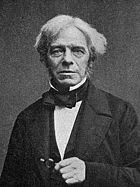

- 1807: Potassium and Sodium are individually isolated by Sir Humphry Davy.
- 1831–1836: Charles Darwin's journey on HMS Beagle.
- 1859: Charles Darwin publishes On the Origin of Species.
- 1861: James Clerk Maxwell publishes On Physical Lines of Force, formulating the four Maxwell's equations.
- 1865: Gregor Mendel formulates his laws of inheritance.
- 1869: Dmitri Mendeleev creates the Periodic table.
- 1873: Maxwell's A Treatise on Electricity and Magnetism published.
- 1877: Asaph Hall discovers the moons of Mars
- 1896: Henri Becquerel discovers radioactivity; J. J. Thomson identifies the electron, though not by name.
Medicine
[edit]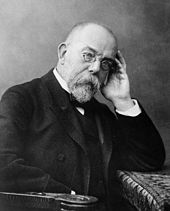
- 1804: Morphine first isolated.
- 1842: Anesthesia used for the first time.
- 1847: Chloroform invented for the first time, given to Queen Victoria at the birth of her eighth child, Prince Leopold in 1853
- 1855: Cocaine is isolated by Friedrich Gaedcke.
- 1885: Louis Pasteur creates the first successful vaccine against rabies for a young boy who had been bitten 14 times by a rabid dog.
- 1889: Aspirin patented.
Inventions
[edit]

- 1804: First steam locomotive begins operation.
- 1816: Laufmaschine invented by Karl von Drais.
- 1825: Erie Canal opened connecting the Great Lakes to the Atlantic Ocean.
- 1825: First isolation of aluminium.
- 1827: First photograph taken (technique of heliography) by Joseph Nicephore Niepce.
- 1825: The Stockton and Darlington Railway, the first public railway in the world, is opened.
- 1826: Samuel Morey patents the internal combustion engine.
- 1829: First electric motor built.
- 1837: Telegraphy patented.
- 1841: The word "dinosaur" is coined by Richard Owen.
- 1844: First publicly funded telegraph line in the world—between Baltimore and Washington—sends demonstration message on 24 May, ushering in the age of the telegraph. This message read "What hath God wrought?" (Bible, Numbers 23:23)
- 1849: The safety pin and the gas mask are invented.
- 1852: The first successful blimp is invented
- 1855: Bessemer process enables steel to be mass-produced.
- 1856: World's first oil refinery in Romania
- 1858: Invention of the phonautograph, the first true device for recording sound.
- 1859: The first ironclad was launched into sea by the French Navy.
- 1860: Benjamin Tyler Henry invents the 16-shot Henry Rifle
- 1861: Richard Gatling invents the Gatling Gun, first modern machine gun used notably in the battles of Cold Harbor and Petersburg
- 1862: First meeting in combat of ironclad warships, USS Monitor and CSS Virginia, during the American Civil War.
- 1863: First section of the London Underground opens.
- 1866: Successful transatlantic telegraph cable follows an earlier attempt in 1858.
- 1867: Alfred Nobel invents dynamite.
- 1868: Safety bicycle invented.
- 1869: First transcontinental railroad completed in United States on 10 May.
- 1870: Rasmus Malling-Hansen's invention the Hansen Writing Ball becomes the first commercially sold typewriter.
- 1873: Blue jeans and barbed wire are invented.
- 1877: Thomas Edison invents the phonograph
- 1878: First commercial telephone exchange in New Haven, Connecticut.
- c. 1875/1880: Introduction of the widespread use of electric lighting. These included early crude systems in France and the UK and the introduction of large scale outdoor arc lighting systems by 1880.[27]
- 1879: Thomas Edison patents a practical incandescent light bulb.
- 1882: Introduction of large scale electric power utilities with the Edison Holborn Viaduct (London) and Pearl Street (New York) power stations supplying indoor electric lighting using Edison's incandescent bulb.[28][29]
- 1884: Sir Hiram Maxim invents the first self-powered Machine gun.
- 1885: Singer begins production of the 'Vibrating Shuttle'. which would become the most popular model of sewing machine.
- 1886: Karl Benz sells the first commercial automobile.
- 1890: The cardboard box is invented.
- 1892: John Froelich develops and constructs the first gasoline/petrol-powered tractor.
- 1894: Karl Elsener invents the Swiss Army knife.
- 1894: First gramophone record.
- 1895: Wilhelm Röntgen identifies x-rays.
Religion
[edit]
- 1818: The first permanent Reform Judaism congregation, the Neuer Israelitischer Tempel, is founded in Hamburg on October 18. Around the same time, through the development of Wissenschaft des Judentums, the seeds of Conservative Judaism are sown.
- 1830: The Church of Jesus Christ of Latter Day Saints is established.
- 1844: The Báb announces his revelation on 23 May, founding Bábism. He announced to the world of the coming of "He whom God shall make manifest". He is considered the forerunner of Bahá'u'lláh, the founder of the Baháʼí Faith.
- 1850s–1890s: In Islam, Salafism grows in popularity.
- 1851: Hong Xiuquan, the leader of the God Worshipping Society, founds the Taiping Heavenly Kingdom.
- 1857: In Paris, France, Allan Kardec, publishes The Spirits' Book and founds the Spiritism.
- 1868: In Japan, State Shinto is established amidst the Meiji Restoration.
- 1869–1870: The First Vatican Council is convened, articulating the dogma of papal infallibility and promoting a revival of scholastic theology.
- 1871–1878: In Germany, Otto von Bismarck challenges the Catholic Church in the Kulturkampf ("Culture War")
- 1875: Helena Blavatsky co-founds the Theosophical Society and becomes the leading articulator of Theosophy.
- 1879: Mary Baker Eddy founds the Church of Christ, Scientist. The Watchtower, published by the Jehovah's Witnesses, releases its first issue.
- 1881: In the Sudan, Muhammad Ahmad claims to be the Mahdi, founding the Mahdist State and declaring war on the Khedivate of Egypt.
- 1889: Mirza Ghulam Ahmad establishes the Ahmadiyya Muslim Community.
- 1891: Pope Leo XIII issues the papal encyclical Rerum novarum, the first major document informing modern Catholic social teaching.
Culture
[edit]
- 1808: Beethoven composes his Fifth Symphony
- 1813: Jane Austen publishes Pride and Prejudice
- 1818: Mary Shelley publishes Frankenstein; or, The Modern Prometheus.
- 1819: John Keats writes his six of his best-known odes.
- 1819: Théodore Géricault paints his masterpiece The Raft of the Medusa, and exhibits it in the French Salon of 1819 at the Louvre.
- 1824: Premiere of Beethoven's Ninth Symphony.
- 1829: Johann Wolfgang von Goethe's Faust premieres.
- 1833–1834: Thomas Carlyle publishes Sartor Resartus.
- 1837: Charles Dickens publishes Oliver Twist.
- 1841: Ralph Waldo Emerson publishes Self-Reliance.
- 1845: Frederick Douglass publishes Narrative of the Life of Frederick Douglass, an American Slave.
- 1847: The Brontë sisters publish Jane Eyre, Wuthering Heights and Agnes Grey.
- 1848: Karl Marx and Friedrich Engels publish The Communist Manifesto.
- 1849: Josiah Henson publishes The Life of Josiah Henson, Formerly a Slave, Now an Inhabitant of Canada, as Narrated by Himself.
- 1851: Herman Melville publishes Moby-Dick.
- 1851: Sojourner Truth delivers the speech "Ain't I a Woman?".
- 1852: Harriet Beecher Stowe publishes Uncle Tom's Cabin.
- 1855: Walt Whitman publishes the first edition of Leaves of Grass.
- 1855: Frederick Douglass publishes the first edition of My Bondage and My Freedom.
- 1862: Victor Hugo publishes Les Misérables.
- 1863: Jules Verne begins publishing his collection of stories and novels, Voyages extraordinaires, with the novel Cinq semaines en ballon.
- 1865: Lewis Carroll publishes Alice's Adventures in Wonderland.
- 1869: Leo Tolstoy publishes War and Peace.

Auguste Renoir, Bal du moulin de la Galette, 1876, Musée d'Orsay - 1875: Georges Bizet's opera Carmen premiers in Paris.
- 1876: Richard Wagner's Ring Cycle is first performed in its entirety.
- 1883: Robert Louis Stevenson's Treasure Island is published.
- 1884: Mark Twain publishes the Adventures of Huckleberry Finn.
- 1886: Strange Case of Dr Jekyll and Mr Hyde by Robert Louis Stevenson is published.
- 1887: Sir Arthur Conan Doyle publishes his first Sherlock Holmes story, A Study in Scarlet.
- 1889: Vincent van Gogh paints The Starry Night.
- 1889: Moulin Rouge opens in Paris.
- 1892: Tchaikovsky's Nutcracker Suite premières in St Petersberg.
- 1894: Rudyard Kipling's The Jungle Book is published
- 1895: Trial of Oscar Wilde and premiere of his play The Importance of Being Earnest.
- 1897: Bram Stoker writes Dracula.
- 1900: L. Frank Baum publishes The Wonderful Wizard of Oz.
Literature
[edit]
On the literary front the new century opens with romanticism, a movement that spread throughout Europe in reaction to 18th-century rationalism, and it develops more or less along the lines of the Industrial Revolution, with a design to react against the dramatic changes wrought on nature by the steam engine and the railway. William Wordsworth and Samuel Taylor Coleridge are considered the initiators of the new school in England, while in the continent the German Sturm und Drang spreads its influence as far as Italy and Spain. French arts had been hampered by the Napoleonic Wars but subsequently developed rapidly. Modernism began.[30]
Goncourts и Emile Zola во Франции и Джованни Верга в Италии производят одни из лучших натуралисты . Итальянские романы натуралистов особенно важны в том смысле, что они дают социальную карту новой объединенной Италии людям, которые до этого до этого едва осознавали его этническое и культурное разнообразие. В 19 веке произошел огромный литературный продукт. Некоторые из самых известных писателей включали русских Александра Пушкина , Николай Гогола , Лео Толстого , Антона Чехова и Фёдора Достоевского ; Английский Чарльз Диккенс , Джон Китс , Альфред, Лорд Теннисон и Джейн Остин ; Шотландский сэр Уолтер Скотт , Томас Карлайл и Артур Конан Дойл (создатель персонажа Шерлока Холмса ); Ирландский Оскар Уайльд ; американцы Эдгар Аллан По , Ральф Уолдо Эмерсон и Марк Твен ; и французский Виктор Хьюго , Гонор де Балзак , Жюль Верн , Александр Дюма и Чарльз Бодлер . [ 31 ]
Некоторые американские литературные писатели, поэты и романисты были: Уолт Уитмен , Марк Твен , Гарриет Энн Джейкобс , Натаниэль Хоторн , Ральф Уолдо Эмерсон , Герман Мелвилл , Фредерик Дуглас , Гарриет Бичер Стоу , Джоэл Чендлер Харрис и Эмили Дикинсон , имена.
Фотография
[ редактировать ]

- Оттомар Аншутц , хронофотограф
- Мэтью Брэди , задокументировал гражданскую войну в США
- Эдвард С. Кертис , задокументировал американский Запад , в частности, коренных американцев
- Луи Дагерре , изобретатель химика процесса фотографии, химика,
- Томас Икинс , фотограф Pioneer Motion
- Джордж Истман , изобретатель Roll Film
- Эркулес Флоренс , изобретатель Pioneer Photography
- Огюст и Луи Люмер , пионерские режиссеры, изобретатели
- Этьен-Жюль Мари , пионерский фотограф, хронофотограф
- Эйдвоард Мюйбридж , пионерский фотограф, хронофотограф
- Nadar Aka Gaspard-Félix Tournachon, портретный фотограф
- Nicéphore niépce , Pioneer Inventor of Photography
- Луи Ле Принс , изобретатель фильма и пионер
- Сергей Прокудин-Горский , химик и фотограф
- Уильям Фокс Тэлбот , изобретатель негативного / позитивного фотографического процесса.
Визуальные художники, художники и скульпторы
[ редактировать ]
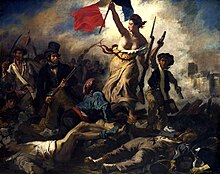


Реализм начала 19 - и романтизм го века уступили импрессионизму и постимпрессионизм в более поздней половине века, а Париж был доминирующей художественной столицей мира. В Соединенных Штатах школа реки Гудзон была видной. Художники 19-го века включали:
- Иван Айвазовский
- Леон выпекается
- Альберт Бирстадт
- Уильям Блейк
- Арнольд Бёклин
- Роза Счастье
- Уильям Бержес
- Мэри Кассатт
- Камилла Кладель
- Пол Сезанн
- Фредерик Эдвин Черч
- Томас Коул
- Ян Матжко
- Джон Констебл
- Камилла Коро
- Густав Курбе
- Погодие Дамье
- Эдгар Дега
- Южен Делакроа
- Томас Икинс
- Каспар Дэвид Фридрих
- Пол Гоген
- Теодор Жеро
- Винсент Ван Гог
- Уильям Моррис
- Франциско Гоя
- Анд Хирошиг
- Хокусай
- Уинслоу Гомер
- Жан-аугуст-доминик Ингрес
- Исаак Левитан
- Разъединенный коврики
- Клод Моне
- Густав Моро
- Берте Морисот
- Эдвард Мунк
- Mikhail Nesterov
- Камилла Писсарро
- Август может
- Пьер-Огуст Ренуар
- Ilya Repin
- Август семьи
- Альберт Пинкхем Райдер
- Джон Сингер Сарджент
- Valentin Serov
- Жорж Сеурат
- Ivan Shishkin
- Васили Суриков
- Джеймс Тиссо
- Анри де Тулуз-Лаврек
- Джозеф Мэллорд Уильям Тернер
- Viktor Vasnetsov
- Eugène Viollet-le-Duc
- Mikhail Vrubel
- Джеймс Эбботт Макнил Уистлер
- Цукиока Йошитоши
Музыка
[ редактировать ]
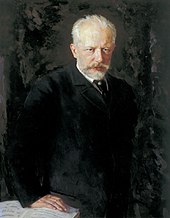
Соната созрела в классическую эпоху, чтобы стать основной формой инструментальных композиций на протяжении 19 -го века. Большая часть музыки 19 -го века была названа в романтическом стиле. Многие великие композиторы пережили эту эпоху, такую как Людвиг Ван Бетховен , Франц Лист , Фрейдрик Шопен , Пиотр Ильях Чайковский и Ричард Вагнер . Список включает в себя:
- Мили Балакирев
- Людвиг Ван Бетховен
- Гектор Берлиоз
- Жорж Бизет
- Alexander Borodin
- Йоханнес Брамс
- Антон Брукнер
- Фрэдерик Шопен
- Клод Дебюсси
- Антонин Двохак
- Михаил Глинка
- Эдвард Григ
- Скотт Джоплин
- Александр Леви
- Францкая мука
- Густав Малер
- Феликс Мендельсон
- Модест Мусоргский
- Жак Оффенбах
- Никколо Паганини
- Николай Римский-Корсаков
- Джиоахино Россини
- Антон Рубинштейн
- Камилла Сен-Санс
- Антонио Сальери
- Франц Шуберт
- Роберт Шуманн
- Александр Скриабин
- Артур Салливан
- Pyotr Ilyich Chaikovsky
- Джузеппе Верди
- Ричард Вагнер
Спорт
[ редактировать ]- 1858 : Мельбурнский футбольный клуб был сформирован, начав спорт австралийских правил футбола
- 1867 : правила Marques of Queensberry для бокса . Опубликованы
- 1872 первый признанный международный футбольный матч между Англией и Шотландией . : играет
- 1877 : первый тестовый матч в крикет, между Англией и Австралией , играется.
- 1891 : баскетбол изобретен Джеймсом Нейсмитом .
- 1895 : волейбол изобретен.
- 1896 : Олимпийские игры возродились в Афинах .
События
[ редактировать ]1801–1850
[ редактировать ]- 1801 : Королевство Великобритания и Королевство Ирландия объединяются, чтобы сформировать Великобритания .
- 1802 : Ваххабиты первого мешка штата Саудовской Аравии Карбала .
- 1803 : Уильям Симингтон демонстрирует свою Шарлотту Дандас , «Первый практический пароход».
- 1803 : Ваххабиты первой штата Саудовской Аравии захватывают Мекку и Медину .
- 1804 : Австрийская империя основанная Фрэнсисом I. ,
- 1804 : Население мира достигает 1 миллиарда.
- 1805 : Битва при Трафальгаре устраняет французские и испанские военно -морские флоты и допускает британское господство в морях, что является основным фактором успеха Британской империи в конце столетия.
- 1805 - 1848 : Мухаммед Али модернизирует Египет .

- 1810 : Берлинский университет был основан. Среди его студентов и преподавателей - Гегель , Маркс и Бисмарк . Реформа Германии университета оказывается настолько успешной, что его модель скопирована по всему миру (см. Историю европейских исследовательских университетов ).
- 1814 : Элиша Коллиер изобретает Flintlock револьвер .
- 1814 : 1 февраля извержение вулкана Мэйона
- 1815 : апрель, извергается гора Тамбора на острове Сумбава , становясь крупнейшим извержением вулкана в зарегистрированной истории , разрушив культуру Тамбора и убивая не менее 71 000 человек, включая ее последствия. Извержение создало глобальные климатические аномалии, известные как « вулканическая зима ». [ 32 ]
- 1816 : Год без лета : необычно холодные условия наносят ущерб на протяжении всего северного полушария, на который, вероятно, повлиял взрыв 1815 года на горе Тамбору .
- 1816 - 1828 : Шаки Королевство Зулу становится крупнейшим в южной части Африки .
- 1819 : Республика Колумбия ( Гран Колумбия ) достигает приложения независимости Симона Боливара триумфа в битве при Бояка .
- 1819 : Современный город Сингапур создан Британской Ост -Индской компанией .
- 1820 : Открытие Антарктиды .
- 1820 : Либерия , основанная Американским обществом колонизации для освобожденных американских рабов.
- 1820 : Распад империи Маратхи .
- 1821-1823 правительство в , как первое : Первая Мексиканская империя Мексике после независимости, управляемое императором Агустином I из Мексики .
- 1822 : Педро I из Бразилии объявил независимость Бразилии от Португалии 7 сентября.
- 1823 : Доктрина Монро объявила президентом США Джеймсом Монро .
- 1825 : Декабрьское восстание .

- 1829 : Сэр Роберт Пил основает столичную полицейскую службу , первую современную полицию.

- 1830 : англо-российское соперничество над Афганистаном, великая игра , начинается и завершается в 1895 году.
- 1831 : Ноябрьское восстание заканчивается сокрушительным поражением Польши в битве при Варшаве .
- 1832 : Британский парламент принимает Закон о великой реформе .
- 1834-1859 на Восстание : Имама Шамила занятости Россией Кавказ .
- 1835-1836 Республике в Мексике : Техасская революция привела к недолгой Техас .
- 1836 : Сэмюэль Колт популяризирует револьвер и создает компанию огнестрельного оружия для производства своего изобретения револьвера Colt Paterson , шести пуль с огнестрельным оружием, выстрелив один за другим без перезагрузки вручную.
- 1837 - 1838 : восстания 1837 года в Канаде .
- 1838 : К этому времени 46 000 коренных американцев были насильственно перемещены в следе слез .
- 1839 - 1860 : После первого и второго опиумных войн , Франция, Великобритания, Соединенные Штаты и Россия получают много торговых и связанных с ними уступок от Китая, что привело к началу упадка династии Цин .
- 1839-1919 : Англо приводят к -афганские войны тупике и установлению линии Дюранда
- 1842 : Договор о нанкинских седатах Гонконг для англичан.
- 1843 : Первый повозки повозки отправляется из Миссури.
- 1844 : Рочдейл Общество справедливых пионеров устанавливает то, что считается первым кооперативом в мире.
- 1845 - 1849 : Великий голод Ирландии ведет к ирландской диаспоре .
- 1848 : Коммунистический манифест опубликовал.
- 1848 : Конвенция Сенека Фолс является первой конвенцией о правах женщин в Соединенных Штатах и ведет к битве за избирательное право женщин .
- 1848 - 1855 : Калифорнийская золотая лихорадка .
- 1849 : Самый ранний записанный воздушный рейд , поскольку в Австрии работают 200 воздушных шаров для доставки боеприпасов против Венеции .
- 1850 : маленький ледниковый период заканчивается примерно в это время.
- 1850 : Франц Германн Шульце-Дэлицш устанавливает первое совместное финансовое учреждение .

1851–1900
[ редактировать ]- 1851 : Великая выставка в Лондоне была первой в мире международной выставкой или мировой ярмаркой .
- 1852 : Фредерик Дуглас произносит свою речь «Значение четвертого июля для негров» в Рочестере, штат Нью -Йорк .
- 1857 : Сэр Джозеф Уитворт разрабатывает первую снайперскую винтовку на большие расстояния .
- 1857 - 1858 : Индийское восстание 1857 года . Британская империя берет на себя контроль над Индией из Ост -Индской компании .
- 1858 : Строительство Биг Бена завершено.
- 1859 - 1869 : Суэцкий канал построен.

- 1860 : Джузеппе Гарибальди запускает экспедицию тысячи .
- 1861 : Россия отменяет крепость .
- 1862-1877 северо на : мусульманское восстание -западе Китая.
- 1863 : Формирование Международного Красного Креста сопровождается принятием Первой Женевской конвенции в 1864 году.
- 1865 - 1877 : реконструкция в Соединенных Штатах; Рабство запрещено в Соединенных Штатах Тринадцатой поправкой к Конституции Соединенных Штатов .
- 1867 : Канада создана в процессе канадской конфедерации .
- 1868 : Майкл Барретт - последний человек, которого публично повесили в Англии.
- 1869 : Суэцкий канал открывает связывание Средиземноморья с Красным морем .


- 1870 : официальное демонтаж системы культивирования и начало « либеральной политики » дерегулированной эксплуатации Нидерландов Ост -Индии. [ 33 ]
- 1870 - 1890 : Длинная депрессия в Западной Европе и Северной Америке .
- 1871 - 1872 г .: Голод в Персии , как полагают, вызвал смерть 2 миллионов.
- 1871 : Парижская коммуна кратко управляет французской столицей.
- 1872 : Национальный парк Йеллоустон , первый национальный парк . Создан
- 1874 : Кооператив анонимных художников, скульпторов, граверов скульпторов и скульпторов ,
- 1874 : Движение по домашнему правилу установлено в Ирландии .
- 1875 : HMS Challenger обследовает самая глубокая точка в океанах Земли, Deeplenger Deep
- 1876 : Битва за маленький Бигхорн ведет к смерти генерала Кастера и победы для альянса Лакоты , Шайенна и Арапахо
- 1876 - 1914 : массовое расширение населения, территории, промышленности и богатства в Соединенных Штатах называется позолоченным возрастом .
- 1877 : Большая железнодорожная забастовка в Соединенных Штатах, возможно, была первой в мире общенациональной рабочей забастовкой .
- 1881 : Волна погромов начинается в Российской империи.
- 1881 - 1882 : Законы о паромах Жюля приняты во Франции, устанавливая бесплатное, светское образование.
- 1883 : Взрыв вулкана Кракатоа , один из крупнейших в современной истории.
- 1883 : квагга вымер.
- 1886 : Строительство Статуи Свободы ; Coca-Cola разработана.
- 1888 : Основание судоходной линии Koninklijke paketvaart-maatschappij (kpm), которая поддерживала объединение и развитие колониальной экономики. [ 33 ]
- 1888 : Золотой закон отменяет рабство в Бразилии .
- 1889 : Эйфелева башня открыта в Париже .
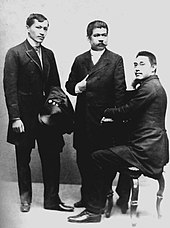
- 1889 : Республиканский военный переворот устанавливает первую бразильскую республику . Парламентская конституционная монархия отменена.
- 1889 - 1890 : 1889–1890 Пандемия убивает 1 миллион человек.
- 1890 : Первое использование электрического кресла в качестве метода исполнения.
- 1892 : мировая колумбийская экспозиция, состоялась в Чикаго отмечающая 400 -летие прибытия Кристофера Колумба в Новый Свете .
- 1892 : снятие отпечатков пальцев официально принято впервые.
- 1893 : Новая Зеландия становится первой страной, которая придерживается избирательного права женщин .
- 1893 : Закон Coremans-De Vriendt принят в Бельгии , создавая законное равенство для французских и голландских языков .
- 1894 : голландское вмешательство в Ломбок и Карангасим [ 33 ] привел к разграблению и разрушению Какранегарского дворца в Матараме . [ 34 ] JLA Brandes, голландский филолог, обнаруживает и обеспечивает его переписываемую рукопись в Королевской библиотеке Ломбока.
- 1896 : Филиппинская революция заканчивает объявление о Филиппинах свободными от испанского правления.
- 1898 : Соединенные Штаты получают контроль над Кубой , Пуэрто -Рико и Филиппинами после испанской американской войны .
- 1898 : вдовская императрица Cixi из Китая инженеры, переворотный переворот, отмечающий конец реформы сто дней ; Император Гуансу арестован.
- 1900 : Exposition Universelle проводилась в Париже, где представлены растущая тенденция искусства .
- 1900 - 1901 : восемь стран вторгаются в Китай одновременно и разрывают запретный город .
Последние выжившие
[ редактировать ]родился 19 апреля 1897 года Японский Джироемон Кимура . [ 35 ] [ 36 ] [ 37 ] Кимура остается на сегодняшний день самым старым проверенным человеком в истории . [ 38 ] Впоследствии, 21 апреля 2018 года, японская Наби Таджима (родилась 4 августа 1900 года), как последний человек, который, как верный, родился в столетии. [ 39 ]
Дополнительная портретная галерея
[ редактировать ]-
Виктор Хьюго , ок. 1876
-
Луи Пастер , 1878
-
Мари Кюри , ок. 1898
-
Лео Толстой , ок. 1897
-
Артур Римбо , ок. 1872
-
Марк Твен , 1894
-
Генри Дэвид Торо , 1861
-
Эмиль Зола , c. 1900
-
Fyodor Dostoevsky , 1876
-
Джон Л. Салливан в его расцвете, ок. 1882
-
Джесси и Фрэнк Джеймс , 1872
-
Мэтью Брэди , автопортрет, c. 1875
-
Пол Сезанн , автопортрет, 1880–1881 гг.
-
Никколо Паганини , c. 1819
-
Frédéric Chopin , 1838
Смотрите также
[ редактировать ]- Сроки современной истории
- Длинный девятнадцатый век
- 19 -й век в кино
- 19 -й век в играх
- Философия 19-го века
- Театр девятнадцатого века
- Международные отношения (1814–1919)
- Список войн: 1800–1899
- Викторианец был
- Франция в длинном девятнадцатом веке
- История Испании (1808–1874)
- История России (1855–1892)
- Рабство в Соединенных Штатах
- Временная шкала истории мусульман 19-го века
- График исторических изобретений
Ссылки
[ редактировать ]- ^ Кливленд, Уильям Л.; Бантон, Мартин (2016). История современного Ближнего Востока . doi : 10.4324/9780429495502 . ISBN 9780429495502 Полем S2CID 153025861 .
19 -й век часто характеризуется как период напряжения между силами преемственности и изменений. Реформаторы, которые выступали за принятие европейских институтов и технологий, часто изображаются как прогрессивные элементы общества, смешно намечая курс к неизбежно западному двадцатому веку. И наоборот, приверженцы непрерывности, которые с тревогой рассматривали демонтаж исламского ордена и стремились сохранить традиции и сохранить ценности и идеалы, которые так долго служили османским и исламским обществам, иногда изображаются как не что иное, как архаичные реакции. Но мы должны избегать этих упрощенных характеристик, если мы хотим оценить мучительный и опасный процесс преобразования устоявшегося религиозного, социального и политического мировоззрения.
- ^ "Первый телефонный звонок" . www.americaslibrary.gov . Архивировано из оригинала 2015-10-22 . Получено 2015-10-25 .
- ^ «18 декабря 1878 года: пусть будет свет - электрический свет» . Проводной . 18 декабря 2009 г. Архивировано с оригинала 21 октября 2016 года . Получено 4 марта 2017 года .
- ^ Великие изобретения энциклопедии Британии . Энциклопедия Британская .
- ^ «Соединенные Штаты и промышленная революция в 19 веке» . Americanhistory.about.com. 2012-09-18. Архивировано из оригинала 2012-07-28 . Получено 2012-10-31 .
- ^ Лаура дель Кол, Университет Западной Вирджинии, жизнь промышленного работника в Англии девятнадцатого века, архивировав 2008-03-13 на The Wayback Machine
- ^ «Модернизация - изменение населения» . Encyclopædia Britannica . Архивировано из оригинала 6 апреля 2009 года.
- ^ Либерализм в 19 веке архивировал 2009-02-18 на машине Wayback . Encyclopædia Britannica.
- ^ Плавание против рабства. Джо Лосемор Архивировал 2009-01-08 на машине Wayback . Би -би -си.
- ^ Атлантика: могут ли США позволить себе иммиграцию? Архивированный 2010-07-04 на The Wayback Machine . Миграционные новости . Декабрь 1996.
- ^ Перес-Бриньоли, Гектор (1989). Краткая история Центральной Америки . Калифорнийский университет. ISBN 978-0520909762 .
- ^ Rjw Evans и Hartmut Pogge von Strandmann, eds., Revolutions в Европе 1848–1849 (2000) с. V, 4
- ^ «Прокламация эмансипации» . Национальный архив . 6 октября 2015 года. Архивировано с оригинала 6 февраля 2017 года . Получено 15 февраля 2017 года .
- ^ McPherson, JM (2014). «Прокламация об эмансипации и Тринадцатая поправка», в Э. Фонере и Джа Гаррати (ред.), Компаньон читателя в американской истории . Бостон, Массачусетс: Хоутон Миффлин. [1] Получено из архивированного 2018-11-06 на машине Wayback
- ^ «Стенограмма прокламации» . Национальный архив . 6 октября 2015 г.
- ^ «13 -я поправка к Конституции США: отмена рабства» . Национальный архив . 27 января 2016 года. Архивировано с оригинала 16 февраля 2017 года . Получено 15 февраля 2017 года .
- ^ Аксан, Вирджиния (2014-01-14). Османские войны, 1700–1870 гг.: Империя осаждена . Routledge. ISBN 978-1-317-88403-3 .
- ^ Вестер, Рик. «Исторический атлас Европы (17 февраля 1832 года): Первая египетская война» . Omniatlas . Получено 2024-02-18 .
- ^ Рейли, Томас Х. (2004). Восстание Небесного Царства и богохульство империи (1 изд.). Сиэтл: Университет Вашингтона Пресс. ISBN 978-0295801926 .
- ^ WG Beasley, Meiji Restoration (1972),
- ^ Jump up to: а беременный в Керр, Гордон (2012). Короткая история Африки: от происхождения человеческой расы до арабской весны . Harpenden, Herts [UK]: карманные основы. С. 85–101. ISBN 9781842434420 .
- ^ « Способ убийства: фотографии гражданской войны и меняющийся американский ландшафт архив 2017-02-28 на машине Wayback ». Джон Хаддлстон (2002). Johns Hopkins University Press . ISBN 0-8018-6773-8
- ^ Гравюра после «Люди науки, живущих в 1807-8» , Джона Гилберта, выгравированного Джорджем Зобелом и Уильямом Уокером , ссылкой. NPG 1075A, Национальная портретная галерея, Лондон, доступ к февралю 2010
- ^ Смит, HM (май 1941). «Выдающиеся люди науки, живущие в 1807-8» . J. Chem. Образовательный 18 (5): 203. doi : 10.1021/ed018p203 .
- ^ Снайдер, Лаура Дж. (2000-12-23). "Уильям Уэвелл" . Стэнфордский университет. Архивировано из оригинала 2010-01-04 . Получено 2008-03-03 .
- ^ «Устойчивый к мультиругам туберкулез» . Центры для контроля и профилактики заболеваний. 2018-12-31. Архивировано из оригинала 21 апреля 2009 года.
- ^ «Дуговые лампы - как они работают и история» . Edisontechcenter.org .
- ^ Джонатан Дейли, Рост западной власти - сравнительная история западной цивилизации, Bloomsbury Publishing · 2013, стр. 310
- ^ Туран Гонен, Электроэнергетическая инженерия распределения энергии, CRC Press · 2015, стр. 1
- ^ Дэвид Дамрош и Дэвид Л. Пайк, ред. Антология мировой литературы Лонгмана, том: девятнадцатый век (2 -е изд. 2008)
- ^ MH Abrams et al., Eds., Антология английской литературы Norton (9th Ed. 2012)
- ^ Оппенгеймер, Клайв (2003). «Климатические, экологические и человеческие последствия крупнейшего известного исторического извержения: вулкан Тамбора (Индонезия) 1815». Прогресс в физической географии . 27 (2): 230–259. Bibcode : 2003prpg ... 27..230o . doi : 10.1191/0309133303pp379ra . S2CID 131663534 .
- ^ Jump up to: а беременный в Vickers (2005), страница XII
- ^ Уэйу Эрнавати: «Глава 8: Сокровища Lombook», в Colonial Collisters Revisited : Питер Йорс (Ditor) Волтер. 152, публикации CNWS. Выпуск 36 или Mathenes of речного музея для завершения , члены. CNWS Publications, 2007. ISBN 978-90-5789-152-6 . 296 страниц. С. 186–203
- ^ «Самый старый человек в мире когда -либо исполняется 116 лет в Киото, поскольку его здоровье изучается» . Японская ежедневная пресса . 15 апреля 2013 года. Архивировано с оригинала 5 июня 2013 года . Получено 19 апреля 2013 года .
- ^ «Старейшему человеку в мире исполняется 116 лет в Японии» . Франция 24 Международные новости . 19 апреля 2013 года. Архивировано с оригинала 16 июня 2013 года . Получено 19 апреля 2013 года .
- ^ «Самый старый человек в мире Джиромон Кимура исполняется 116 лет в Японии» . Экономические времена . Agence France-Presse . Получено 19 апреля 2013 года .
- ^ Мацуяма, Каноко (27 декабря 2012 г.). «Японский 115-летний становится старшим человеком в истории» . Блумберг . Архивировано из оригинала 29 декабря 2012 года . Получено 28 декабря 2012 года .
- ^ Полити, Даниэль (22 апреля 2018 г.). «Последний известный человек, родившийся в 19 веке, умирает в Японии в 117» . Сланец . Архивировано из оригинала 12 сентября 2023 года . Получено 4 октября 2019 года .
Дальнейшее чтение
[ редактировать ]- Лангер, Уильям. Энциклопедия мировой истории (5 -е изд. 1973); Высоко подробный план событий онлайн бесплатно
- Моррис, Ричард Б. и Грэм В. Ирвин, ред. Энциклопедия Harper of the Modern World: краткая история ссылок с 1760 года по настоящее время (1970) онлайн
- Новая Кембриджская современная история (13 том 1957–79), старый, но тщательный охват, в основном из Европы; сильна по дипломатии
- Похоронить, jpt ed. Новая Кембриджская современная история: вып. 10: Зенит европейской власти, 1830–70 (1964) онлайн
- Crawley, CW, ed. Новая Кембриджская современная история истории IX Война и мир в эпоху потрясений 1793–1830 (1965) онлайн
- Darby, HC и H. Fullard The New Cambridge Modern History, Vol. 14: Атлас (1972)
- Хинсли, Ф.Х., изд. Новая Кембриджская современная история, вып. 11, Материальный прогресс и мировые проблемы 1870–1898 (1979) онлайн
Дипломатия и международные отношения
[ редактировать ]- Олдрич, Роберт (1996). Большая Франция . doi : 10.1007/978-1-349-24729-5 . ISBN 978-0-333-56740-1 .
- Бартлетт, CJ (1996). Мир, война и европейские державы, 1814–1914 . Лондон: Macmillan Education UK. doi : 10.1007/978-1-349-24958-9 . ISBN 978-0-333-62001-4 .
- Бридж, FR & Roger Bullen. Великие державы и европейские государства Система 1814–1914 , 2 -е изд. (2005)
- Gooch, GP (1923). «История современной Европы, 1878-1919» . Журнал Британского института международных дел . 2 (6): 266 . doi : 10.2307/3014586 . JSTOR 3014586 .
- Херринг, Джордж С. Годы опасности и амбиций: иностранные отношения США, 1776–1921 (2017)
- Кеннеди, Пол . Рост и падение великих держав экономические изменения и военный конфликт с 1500–2000 (1987), стресс на экономических и военных факторах
- Лангер, Уильям. Европейские альянсы и выравнивания 1870–1890 (1950); продвинутая история онлайн
- Лангер, Уильям. Дипломатия империализма 1890–1902 гг. (1950); продвинутая история онлайн
- Mowat, RB История европейской дипломатии, 1815–1914 (1922) онлайн бесплатно
- Остерхаммел, Юрген (2014). Трансформация мира: глобальная история девятнадцатого века (PDF) . doi : 10.1515/9781400849949 . ISBN 9781400849949 .
- Портер, Эндрю, изд. Оксфордская история Британской империи: том III: девятнадцатый век (2001)
- Сонтаг, Рэймонд. Европейская дипломатическая история: 1871–1932 (1933), базовое резюме; 425 PP онлайн
- Тейлор, AJP борьба за мастерство в Европе 1848–1918 (1954) 638 стр; продвинутая история и анализ крупной дипломатии; онлайн бесплатно
- Тейлор, AJP «Международные отношения» в FH Hinsley, ed., Новая Кембриджская современная история: XI: материальное прогресс и мировые проблемы, 1870–98 (1962): 542–66. онлайн
- Wesseling, HL (2015). Европейские колониальные империи . doi : 10.4324/9781315844503 . ISBN 9781315844503 .
Европа
[ редактировать ]- Андерсон, MS «Господство Европы»: 1815–1914 (3 -е изд. 2003)
- Blanning, TCW Ed. Девятнадцатый век: Европа 1789–1914 (короткая Оксфордская история Европы) (2000) 320 стр.
- Брун, Джеффри. Европа и французский империум, 1799–1814 (1938) онлайн .
- Кэмерон, Рондо. Франция и экономическое развитие Европы, 1800–1914 гг .
- Эванс, Ричард Дж. Погоня за властью: Европа 1815–1914 (2016), 934 стр.
- Джильде, Роберт. Баррикады и границы: Европа 1800–1914 (3 -е изд. 2003) 544 стр., Онлайн 2 -е изд, 1996 г.
- Grab, Александр (2003). Наполеон и трансформация Европы . Лондон: Macmillan Education UK. doi : 10.1007/978-1-4039-3757-5 . ISBN 978-0-333-68275-3 .
- Мейсон, Дэвид С. Краткая история современной Европы: свобода, равенство, солидарность (2011), с 1700 года
- Мерриман, Джон и Дж. М. Винтер, ред. Европа с 1789 по 1914 год: энциклопедия эпохи промышленности и империи (5 тома 2006)
- Стейнберг, Джонатан. Бисмарк: жизнь (2011)
- Сальми, Ханну. Европа 19 -го века: культурная история (2008).
Африка и Азия
[ редактировать ]- Ajayi, Jf Ade, ed. Общая история ЮНЕСКО, вып. VI, Сокращенное издание: Африка в девятнадцатом веке до 1880 -х годов (1998)
- Акеймпонг, Эммануэль; Бейтс, Роберт Х; Нунн, Натан; Робинсон, Джеймс А., ред. (2014). Развитие Африки в исторической перспективе . doi : 10.1017/cbo9781139644594 . ISBN 9781139644594 .
- Chamberlain, Me The Scramble для Африки (3 -е изд. 2010)
- Коллинз, Роберт О. и Джеймс М. Бернс, ред. История Африки к югу от Сахары .
- Дэвидсон, Базилий Африка в истории, темы и очертания . (2 -е изд. 1991).
- Холкомб, Чарльз (2017). История Восточной Азии . doi : 10.1017/9781316340356 . ISBN 9781107118737 Полем S2CID 140138294 .
- Ладден, Дэвид. Индия и Южная Азия: короткая история (2013).
- Мекеди, Колин. Атлас пингвинов африканской истории (2 -е изд. 1996). выдержка
- Мэнсфилд, Питер и Николас Пелхэм, история Ближнего Востока (4 -е изд, 2013).
- Мерфи, Роудс (2016). История Азии . doi : 10.4324/9781315509495 . ISBN 9781315509495 .
- Пакенхем, Томас. The Scramble для Африки: с 1876 по 1912 год (1992)
Северная и Южная Америка
[ редактировать ]- Bakewell, Peter, история Латинской Америки (Blackwell, 1997)
- Бизли, Уильям и Майкл Мейер, ред. Оксфордская история Мексики (2010)
- Бетелл, Лесли, изд. (1984). Кембриджская история Латинской Америки . doi : 10.1017/chol9780521232234 . ISBN 9781139055161 .
- Черный, Конрад. Восстание к величию: история Канады от викингов до настоящего (2014)
- Бернс, Э. Брэдфорд, Латинская Америка: Краткая история интерпретации , мягкая обложка, Прентис Холл 2001, 7 -е издание
- Хау, Даниэль Уокер. То, что Бог создал: трансформация Америки, 1815–1848 (2009), Пулитцеровская премия
- Киркленд, Эдвард С. История американской экономической жизни (3 -е изд. 1960) онлайн
- Линч, Джон, изд. Латиноамериканские революции, 1808–1826 гг .
- МакФерсон, Джеймс М. Боевой крик свободы Эра гражданской войны (1988) Пулитцеровская премия за историю США
- Парри, JH Короткая история Вест -Индии (1987)
- Паксон, Фредерик Логан. История американской границы, 1763–1893 (1924) онлайн , Пулитцеровская премия
- Уайт, Ричард. Республика, для которой она стоит: Соединенные Штаты во время реконструкции и позолоченного возраста, 1865–1896 (2017)
Первичные источники
[ редактировать ]- de Bary, Wm. Теодор, изд. Источники восточной азиатской традиции, вып. 2: современный период (2008), 1192 стр.
- Кертес, Джордж Эд документов в политической истории Европейского континента 1815–1939 (1968), 507 стр; Несколько сотен коротких документов
Внешние ссылки
[ редактировать ] СМИ, связанные с 19 веком в Wikimedia Commons
СМИ, связанные с 19 веком в Wikimedia Commons








